Yes, it’s the same little girl whose portrait captured so many hearts, and she is just as crazy about birds as when we she found that sparrow in the tree last year, but now, at three years of age, she is flying with the birds! She went bungee jumping at the Kane County (IL) Fair. Here, she looks forward to the adventure as Papi helps strap her into the harness.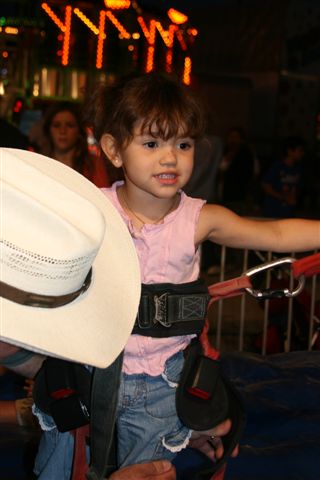
Up, Up, and Away!!!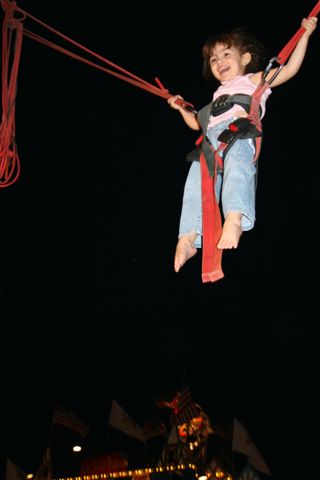
Am I sure I am going to like this? 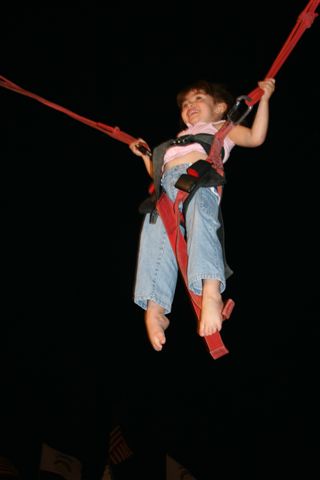
Free Fall!!!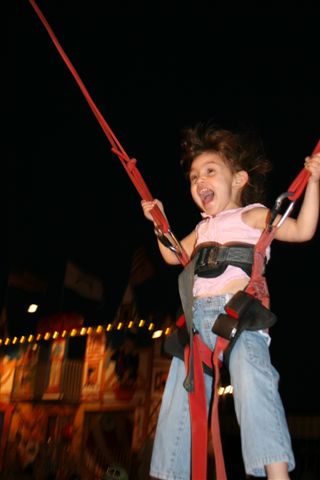
Approaching Terra Firma!!!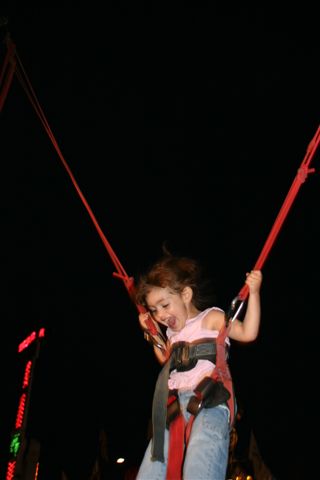
OK– Let’s do it again!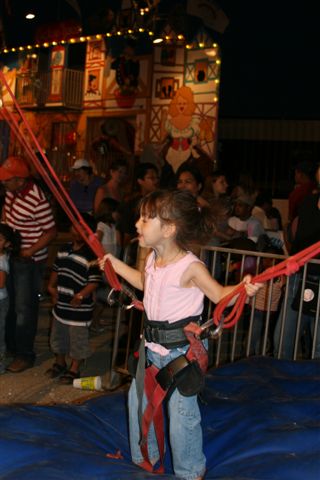
Seeing these pictures, Grandma and Grandpa are ready for their grandbaby fix, so off we go! Don’t even need a hurricane to chase us out of South Florida. We collected four more parsley caterpillars and hope that the children will get to see them turn into butterflies (if they make it through Homeland Security at the airport!).
Earlier this month, I decided to leave my parsley plant to the mercy of the Black Swallowtail caterpillars that were devouring it at an alarming rate. The early larval stages (termed instars) molt several times, changing their appearance more or less dramatically between molts. The earliest instars are dark and have a white saddle, making them look very much like bird droppings.
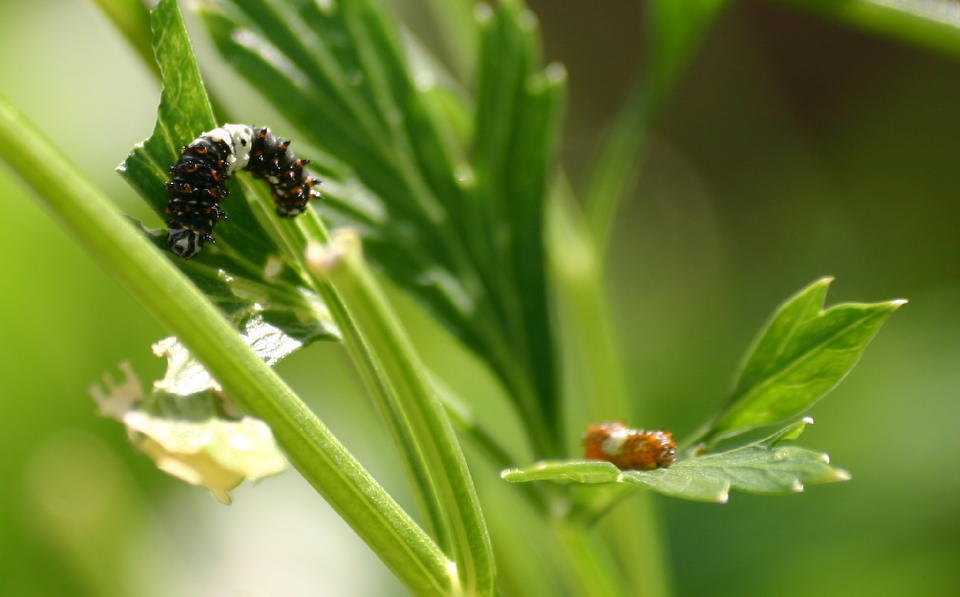
Two early instars (Click for full screen view)
Some of the earliest instars, somewhat tan in color, were only about 4 millimeters long. This one was about 11 millimeters:
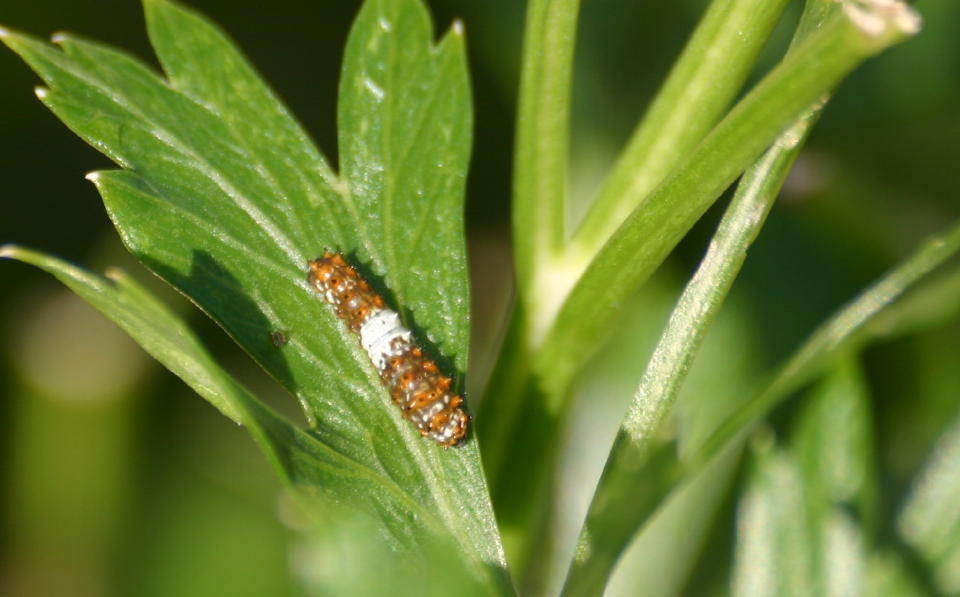
Very early instar (Click for full screen view)
This one was older and darker, measuring approximately 16 millimeters:
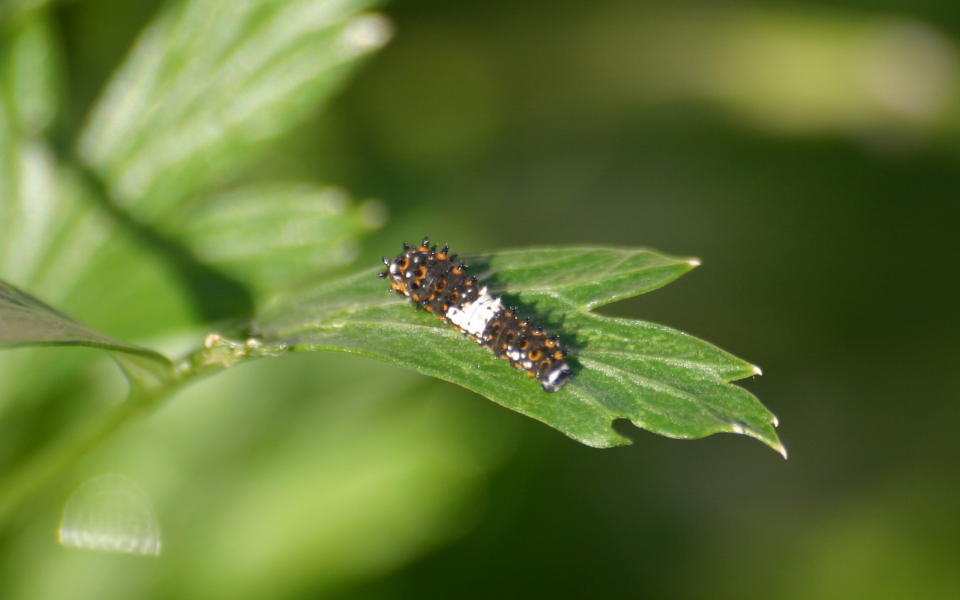
Early Instar (Click for full screen view)
After another molt, about two days later, this caterpillar retained some of the white saddle.It measured about 2 cm.
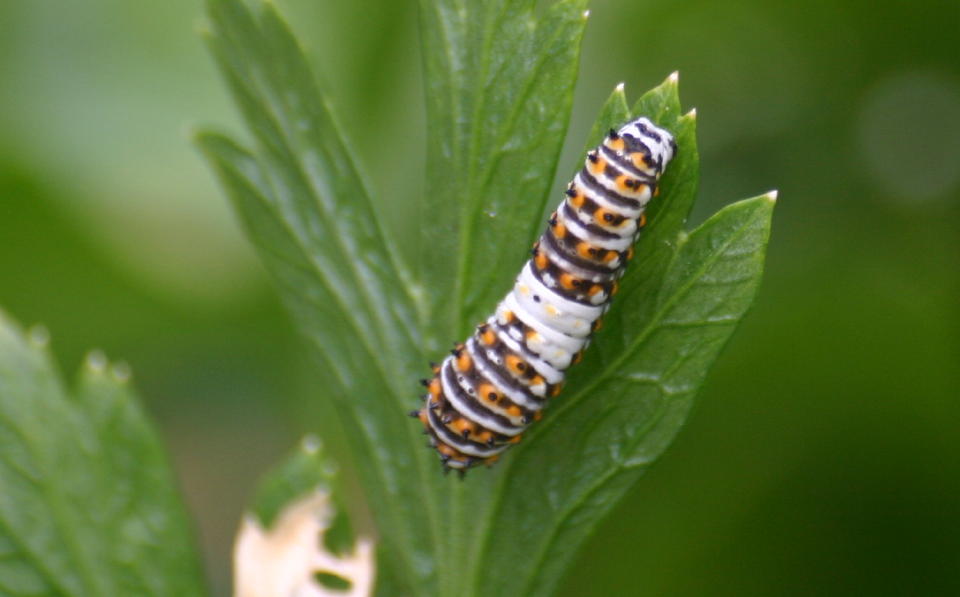
Intermediate Instar (Click for full screen view)
When I first discovered the infestation, there were several caterpillars in more advanced stages. I decided to watch them to see if I could find a chrysalis. One by one, they disappeared , and hard as I tried, I could not find any among the parsley or nearby plants.
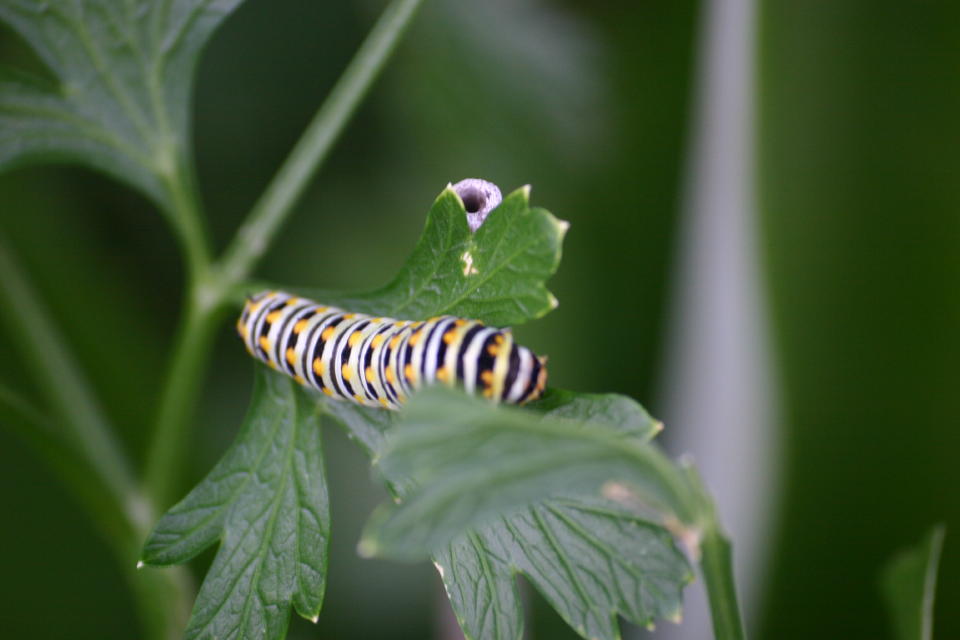
July 8 Later Stage Instar (Click for full screen view)
When there were only two left, I collected this one and brought him into the kitchen on a generous sprig of parsley, hoping to watch it pupate.
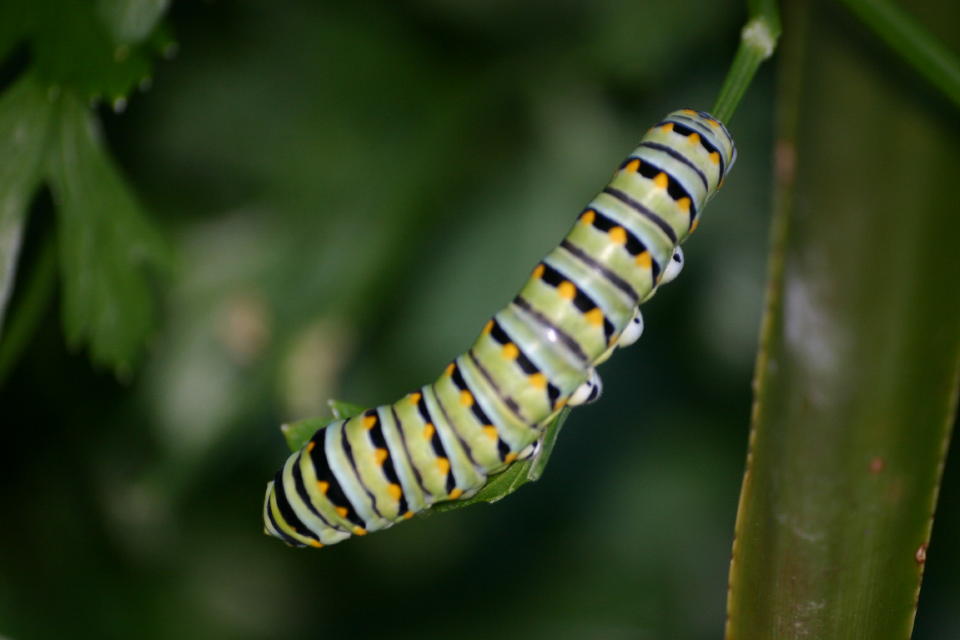
July 10 Late Stage Instar (Click for full screen view)
The caterpillar was truly an eating machine, devouring entire parsley leaves in a couple of minutes and depositing large amounts of feces. Its head area began to swell noticeably. Then, on the third day of captivity, it stopped eating and assumed this crooked position, remaining immobile for the entire day. Note the strand of silk that it had spun as a kind of sling that will help support it as a chrysalis.
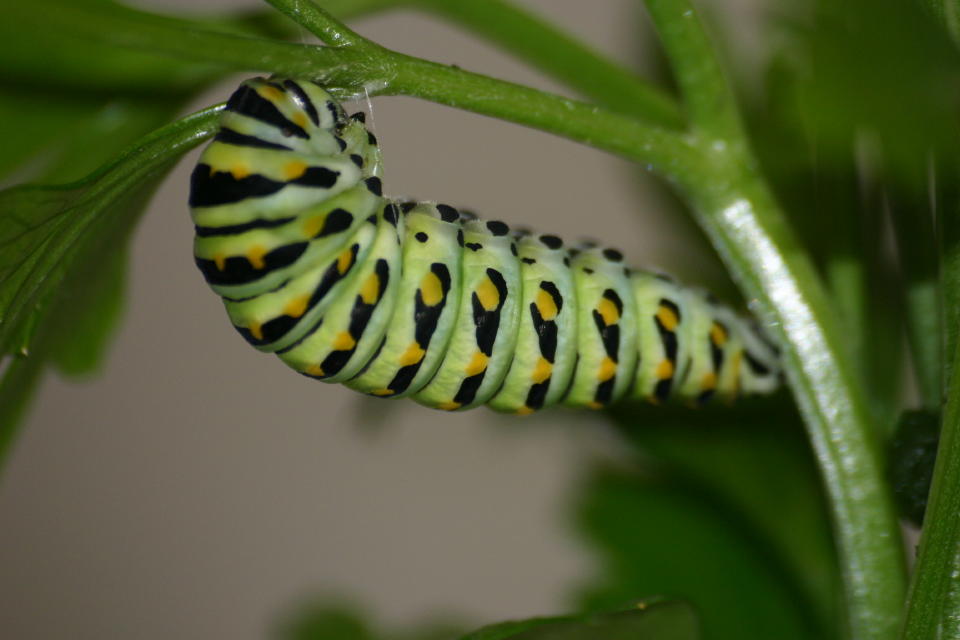
July 13 Nearing pupal stage (Click for full screen view)
I hoped to see it actually morph into the chrysalis, but it looked about the same when I went to bed at 11 PM. The next morning, I first thought it had escaped, as it was nowhere to be seen. I was amazed how the new chrysalis blended into the parsley leaves. Its newly cast off skin was just underneath it.
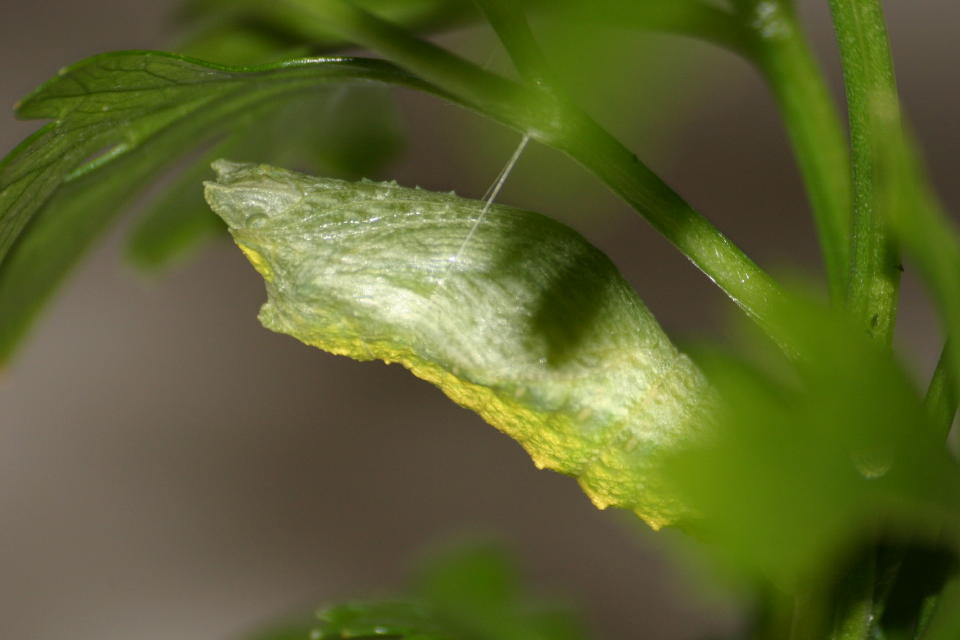
July 14 New Chrysalis (Click for full screen view)
The protuberance under its head seemed to grow a bit by the next day, but its color and appearance were otherwise unchanged.
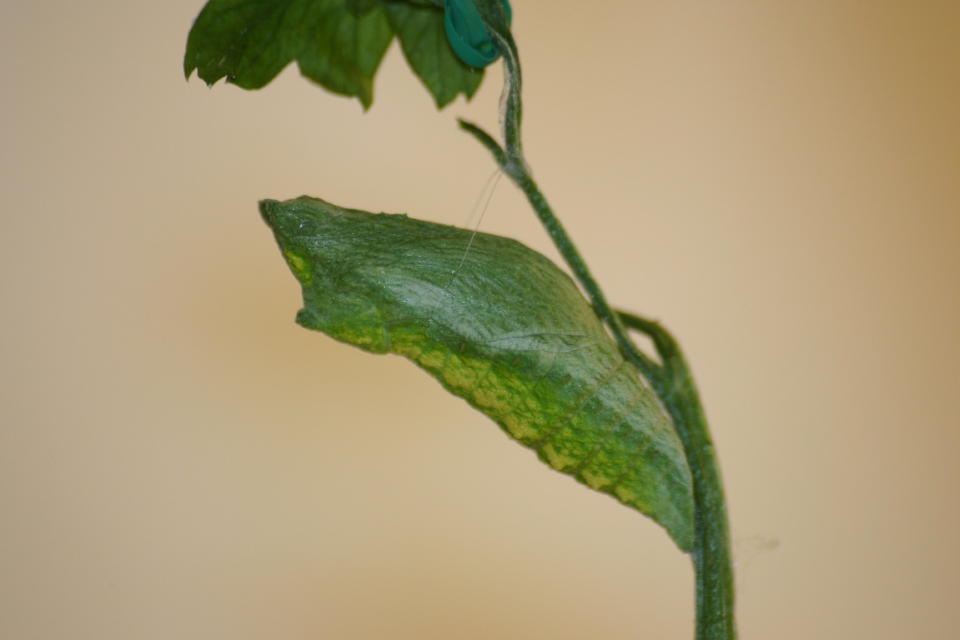
July 15 Second-day Chrysalis (Click for full screen view)
At about the one week point, the dark body of the butterfly inside the chrysalis became more apparent.On the ninth day, the wing spots were visible and we knew the butterfly was ready to emerge. We watched the British Open on TV, but did check a couple of times.
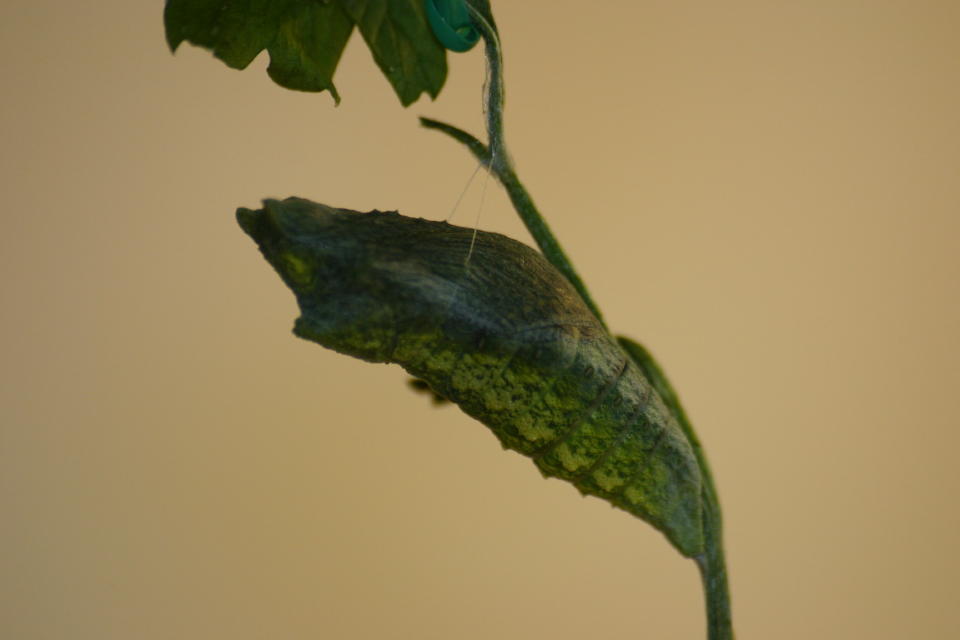
July 22 9:18 AM, Ninth Day, Chrysalis, 7 hours before emerging (Click for full screen view)
Just after 2 PM, the chrysalis appeared to be intact, but even more swollen and quite dark. Note the spots on the butterfly’s abdomen showing through the pupal case:
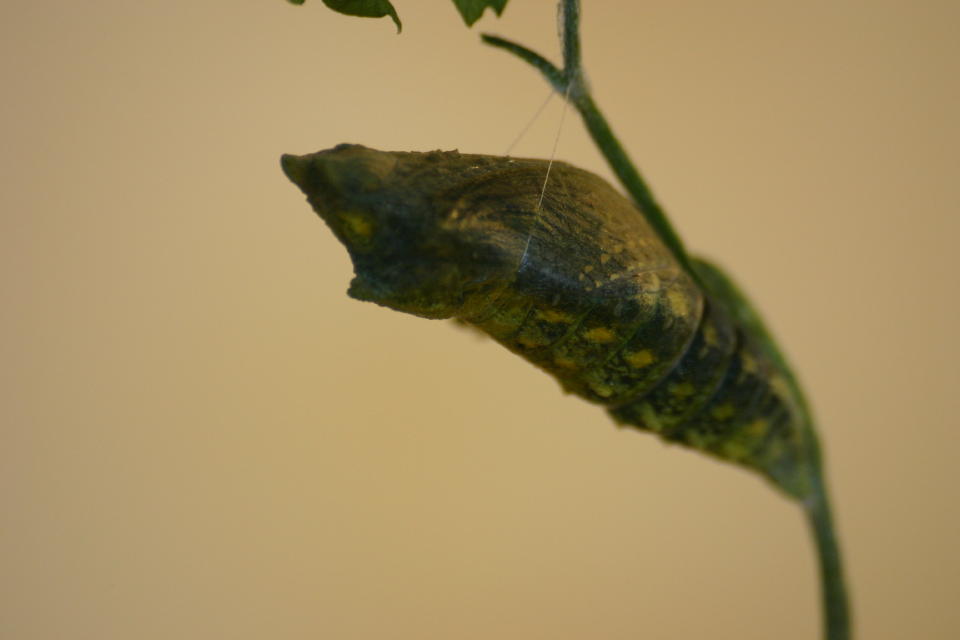
July 22, 2:19 PM, 2 hours before emerging (Click for full screen view)
The British Open had a thrilling finish, and we forgot to check it until just after 4 PM, when we were greeted by the newly emerged butterfly, clinging to the empty chrysalis. Note how swollen the abdomen appears. It began to thin out as the insect pumped fluid into its wing veins:
: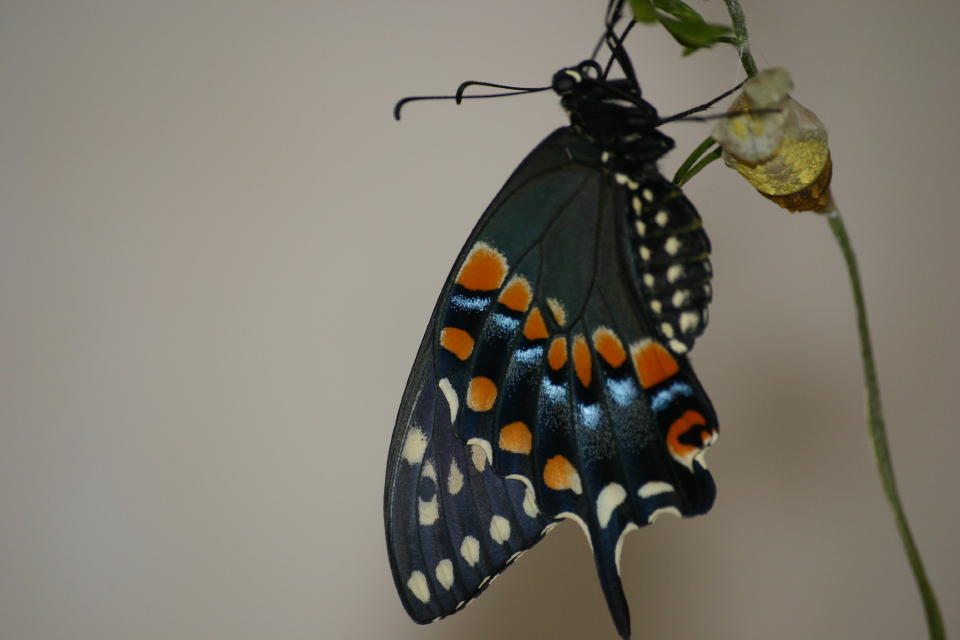
July 22 - 4:14 PM Wings expanding (Click for full screen view)
The Black Swallowtail had emerged. We brought it outside and I took a final photo. It flew away a few minutes later.
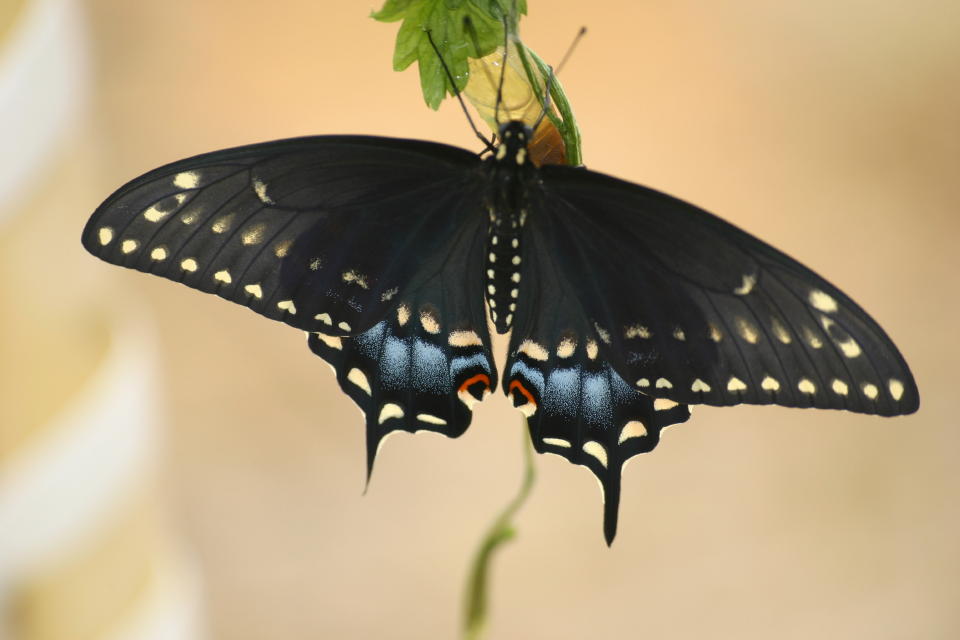
httJuly 22 - 5:28 PM Our last look (Click for full screen view)
The row of yellow spots on the margin of the forewing and the blue band on the hindwing identify this as a female. To find out more about the life history of this butterfly, see Black Swallowtail species description in the Texas A&M Field Guide, and this excellent guide from Montana State University.
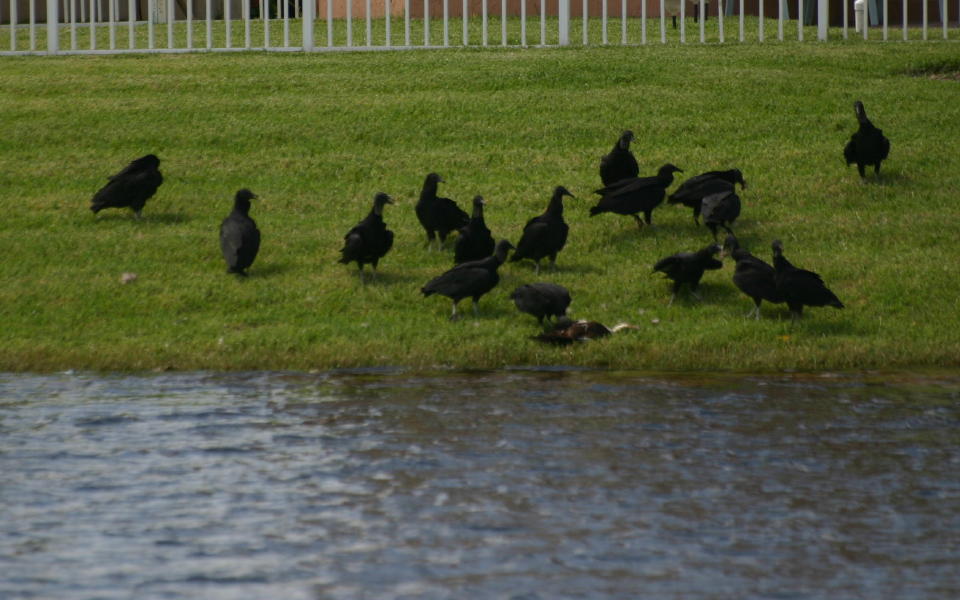
Yesterday morning I found a freshly dead adult White Ibis on our lawn, at the side of the lake. I did not think too much of it. However, a little later, diagonally across the lake, I saw a large group of Black Vultures congregating around the carcass of a freshly dead Muscovy duck. 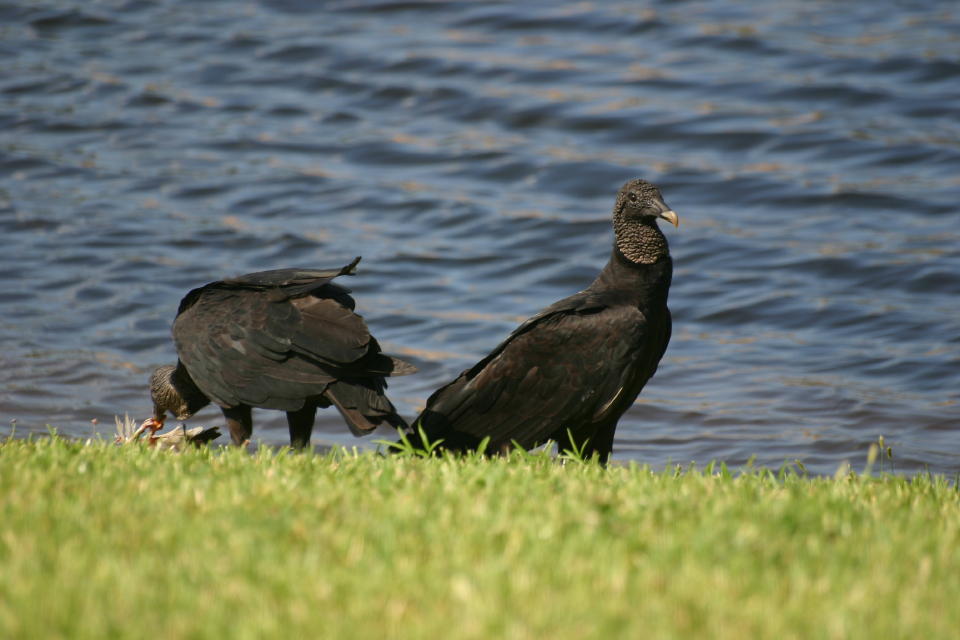
A couple of them came over and finished off the ibis, leaving barely enough for the flies.
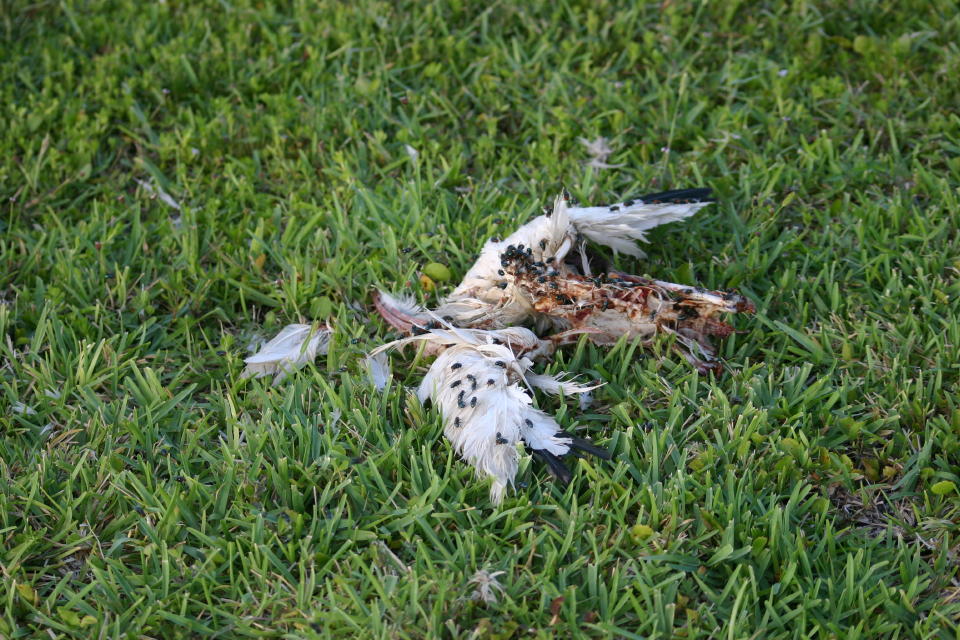
Then, later in the afternoon, a Turkey Vulture started making passes
over the yard next to the one where the first duck had died. It landed
briefly and approached another Muscovy that was sitting on the grass.
As the vulture drew near, the duck began moving toward the lake. It
could not walk normally. Rather, it flopped its wings clumsily and
pretty much crawled into the lake, where it began to thrash violently.
The vulture departed. The duck splashed about for several minutes, and
then fell silent at the water’s edge. Soon the Black Vultures were
feasting on its remains.
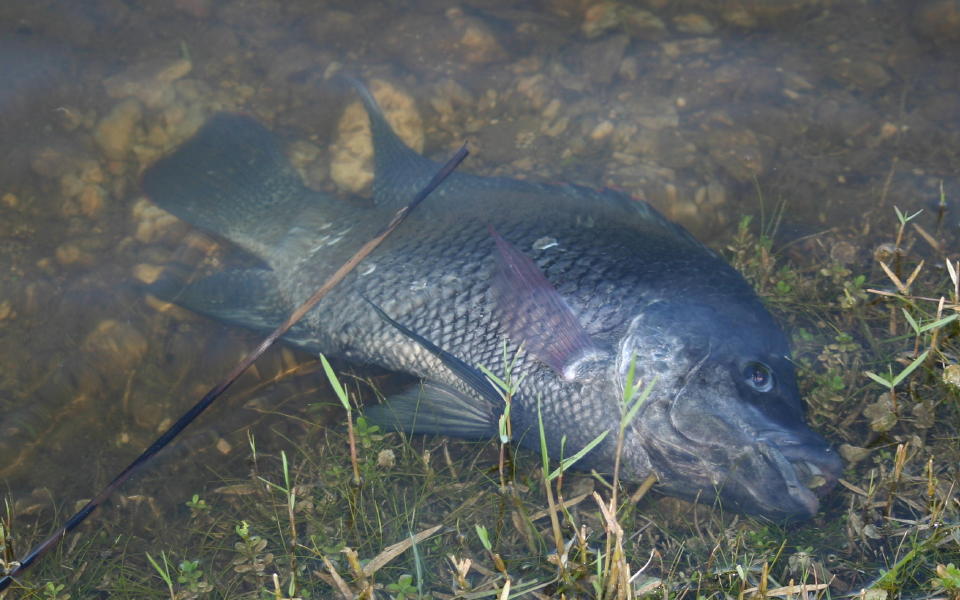
To my surprise, the vultures also moved along to join others that had found yet
another dead duck on the edge of the lake just to the south of our
property. I walked over towards them and found the body of this 16 inch fish, probably a Blue Tilapia, at the water’s edge. Not a good sign.
As dusk was approaching, I noted one of the two “sister” hens that had very similar coloring and facial patterns was out in the back yard, acting strangely. As I approached it, the bird appeared to have trouble balancing and holding its head up. It fell forward as it tried to walk away from me, its head dragging on the ground. It made it to the water, where it swam with its head submerged. Its “sister” swam close by.
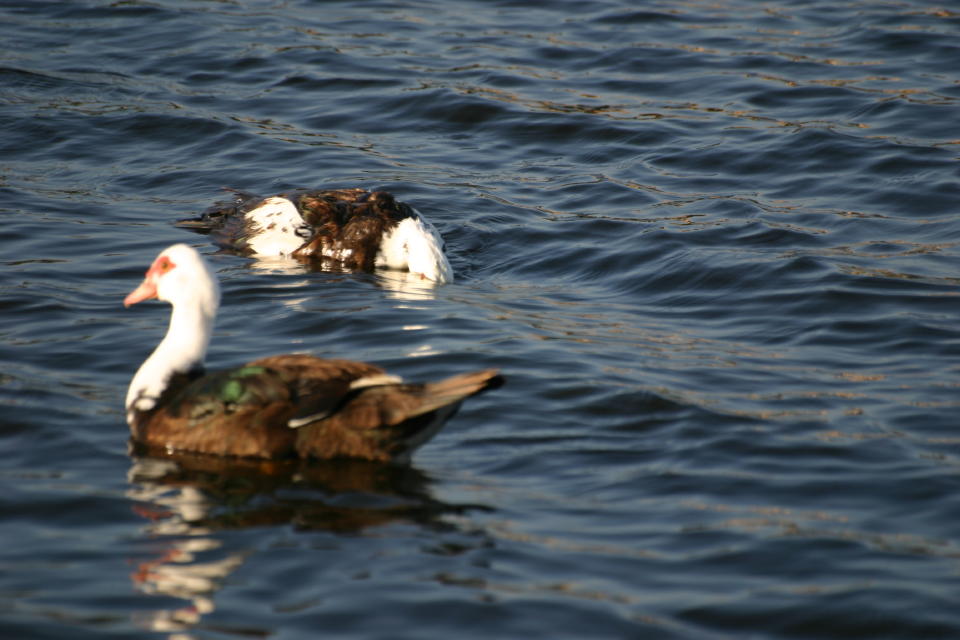
The sick duck tried to breathe every few seconds, flapping its wings to help it thrust its head above water as it gasped for air.
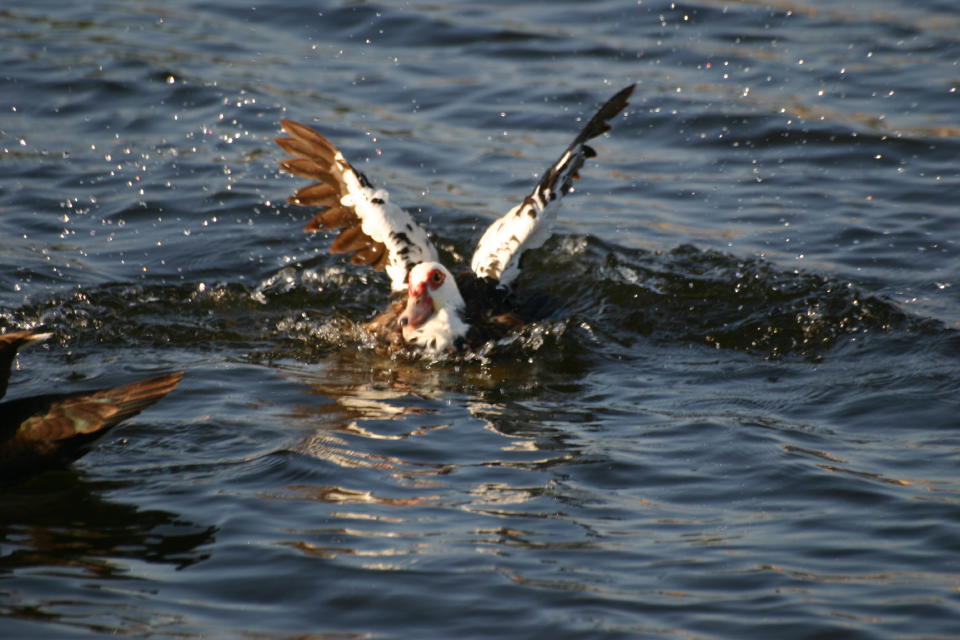
Finally, it made its way back next to the shoreline, where it rested its head on the lake’s edge, not moving. It was touching to see its “sister” staying close by as the bird expired.
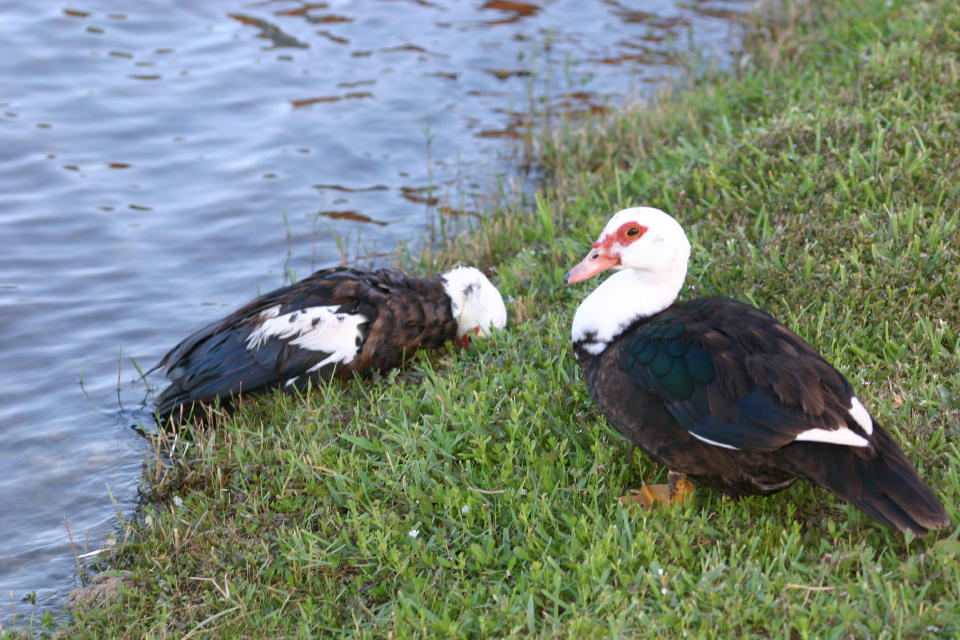
This morning, its body awaited the arrival of the vultures. Across the lake near where the first duck died, there was another body, of a mostly-white Muscovy. That adds up to 5 ducks, one ibis and a fish along a small stretch of shoreline, all dead within 24 hours. Also, perhaps an unrelated event, the brood of 12 ducklings that hatched out last week, pictured in my previous post, had disappeared by the next day
What can be killing these birds? Children sometimes throw rocks at the birds, but no signs of physical injury were evident. It appears to be a neurologic condition. The South Broward Drainage District regularly applies herbicides all along the lake’s edge, but they are said to be only mildly toxic (see this link). Pesticides, particularly organophosphates, are much more toxic to the brain, and they are often used rather indiscriminately, so they must be suspected. “Clinical signs in birds include goose stepping, ataxia, wing spasms, wing droop, dyspnea (difficulty in breathing), tenesmus (spasm of anal sphincter), diarrhea, salivation, lacrimation, ptosis (drooping) of the eyelids, and wing-beat convulsions.”
Then there are disease organisms that affect the central nervous system. West Nile may cause encephalitis, while bird flu would be most unlikely. If I see any more evidence of illness I will call health officials.
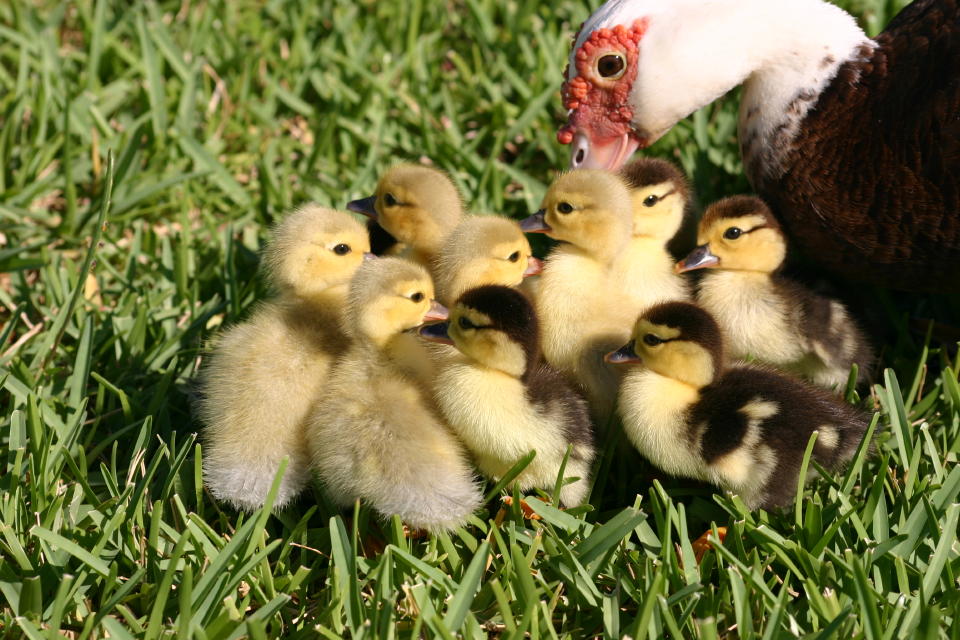
We commented earlier on the lack of Muscovy ducklings on our lake this spring as compared to the three past years we have lived in Florida. Whatever the cause, it appeared to be a local aberration, as the ducks seemed to be reproducing normally on other lakes in our area. The local delay in nesting success may have been related to the social disruption that attended the death of El Presidente, the mean old drake who had ruled over our lakeside back yard for at least two years. Yesterday, the hen that had been incubating a dozen eggs under our cocoplum emerged to show off her new brood.

The rains have already brought our lake levels up to normal and sunfish are tending their circular nests along the shore. This one’s dark gill extensions and the black spot at the base of its dorsal fin tentatively identify it as a Bluegill.
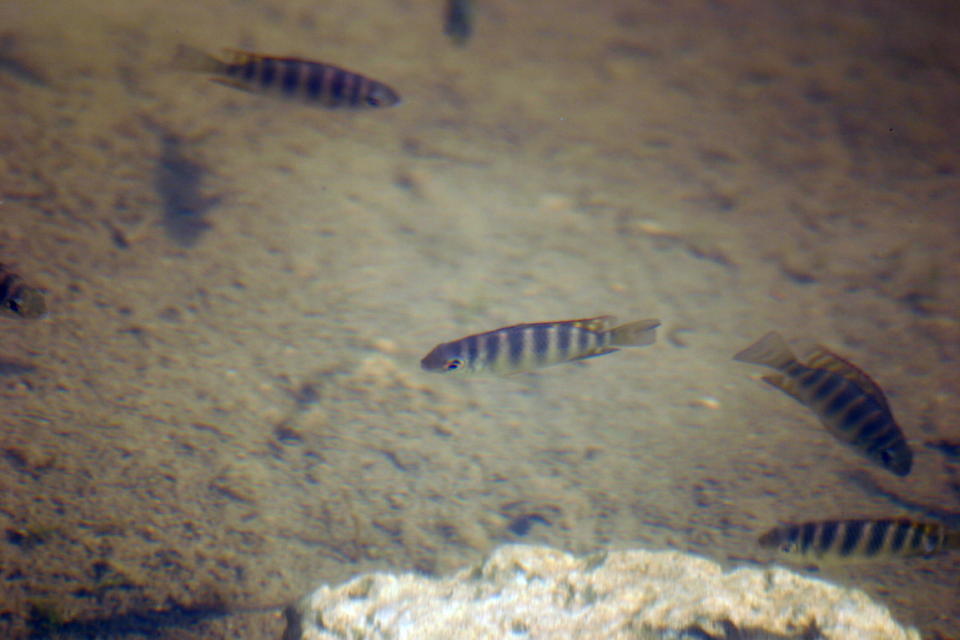
The water is unusually clear, and large schools of 2 to 3 inch fish with 7-8 vertical body stripes are swimming all along the shore. Not sure of the species, but they may be young exotic Spotted Tilapia– I welcome others to help me identify them. Whatever their species, these fish are now attracting good numbers of herons.
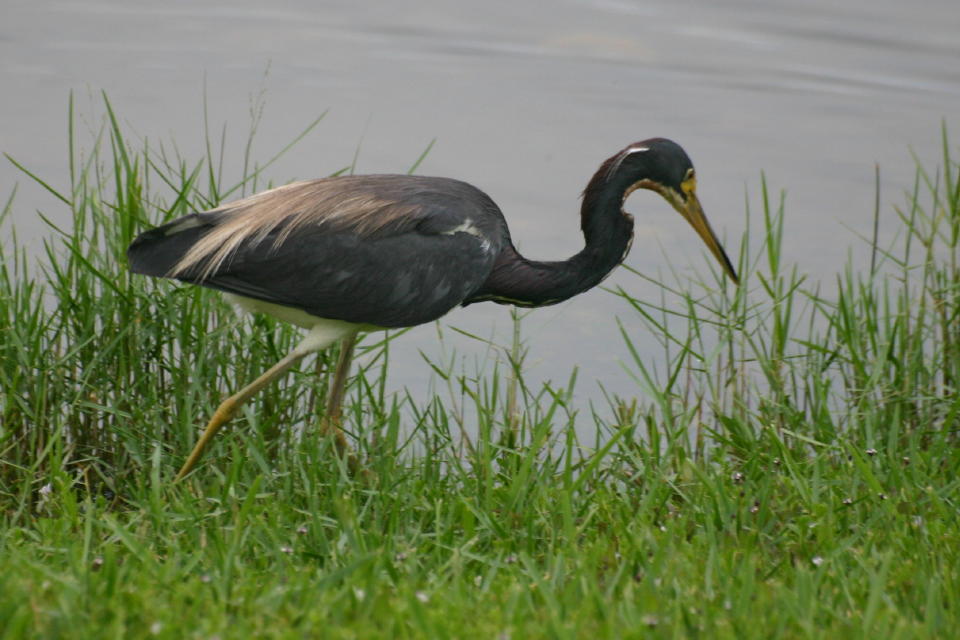
Given such an abundance of food, this Tricolored Heron dashes back and
forth, seemingly unable to settle on any one feeding place at the water’s edge.
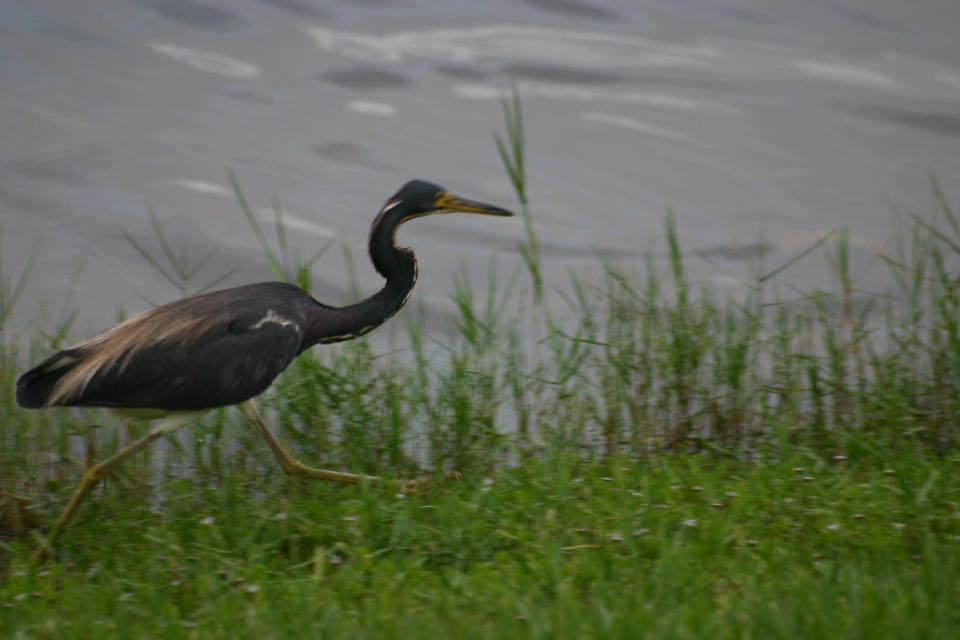
Here, it responds to the disturbance created by a large Grass Carp foraging along the shore.
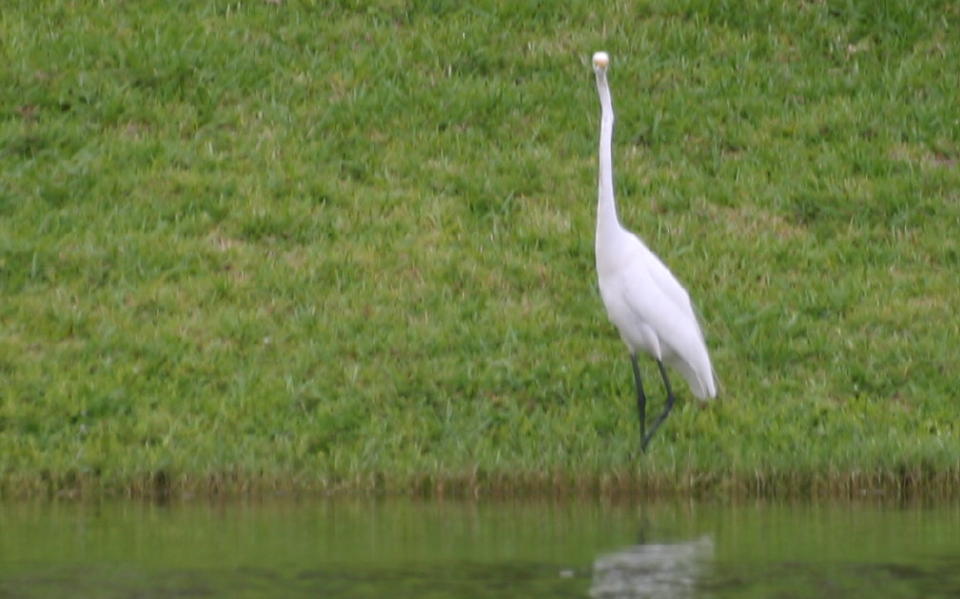
A wary Great Egret denied me any closeups, so I settled for this view of him at about 100 yards.
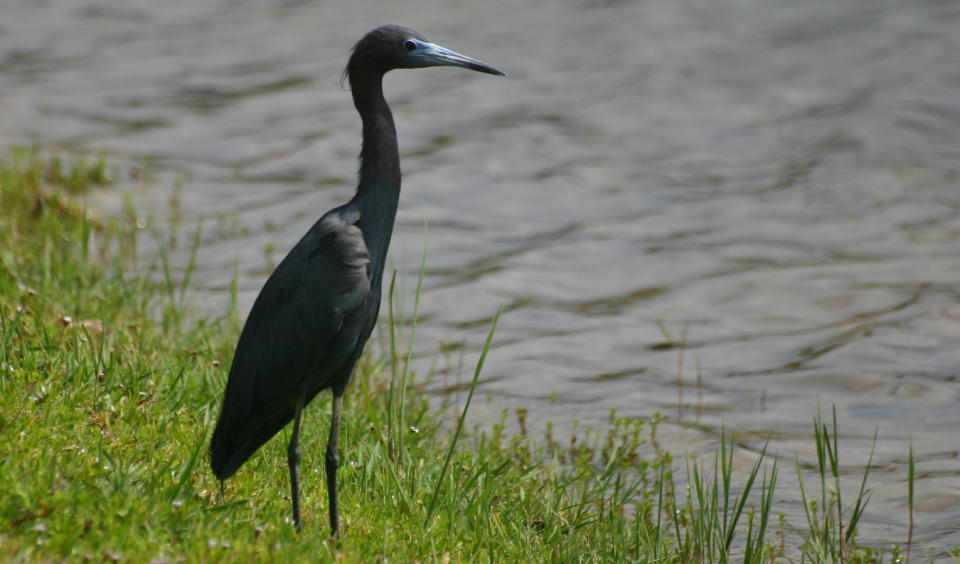
This Little Blue Heron was more cooperative.
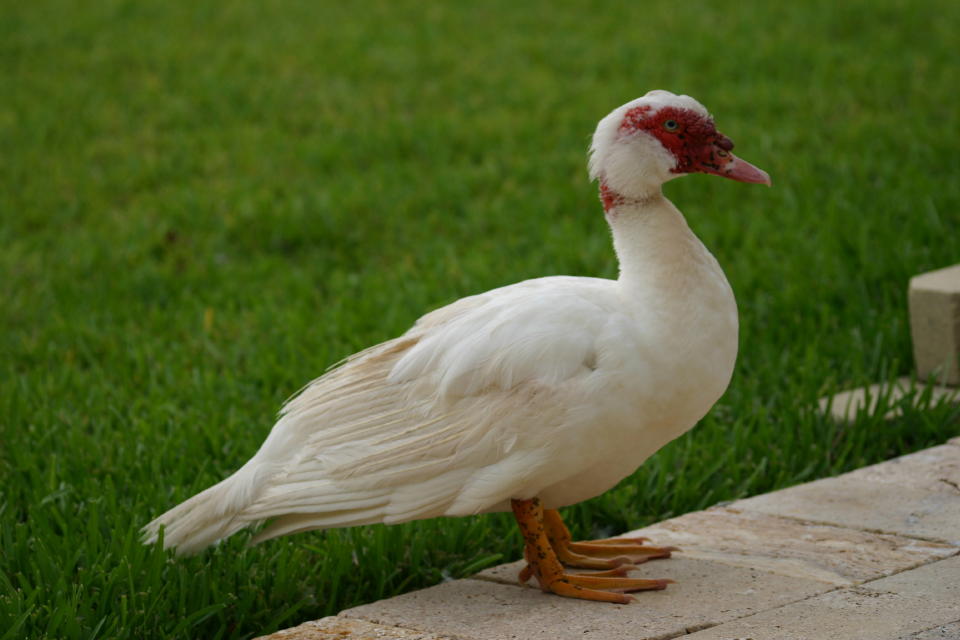
This afternoon, I noticed that more than half my parsley plant seemed to have been cropped off quite neatly. I immediately suspected Old Whitey, the Muscovy Alpha drake who defeated Whitewing to expand his territory into part of our back yard. He looked guilty, as he had been hanging around the herb garden all day. On closer inspection, several brightly colored caterpillars were evident.
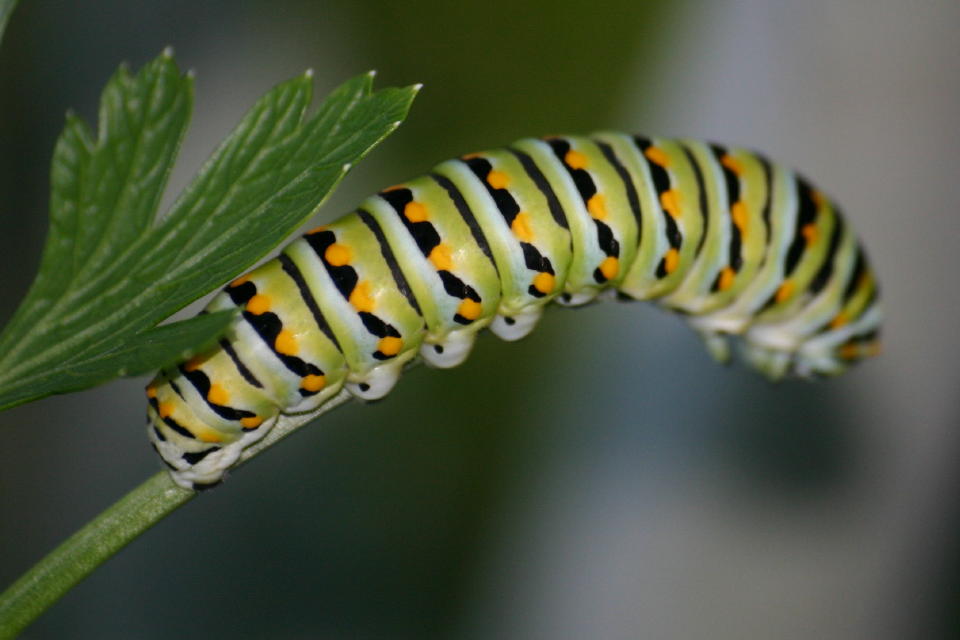
They appeared to be the larvae of the Black Swallowtail. This butterfly species has a particular affinity for parsley. In truth, only a few days ago I saw that the parsley was growing too tall and planned to prune it rather severely, so the caterpillars had spared me the trouble. I will leave them undisturbed and watch their progress.
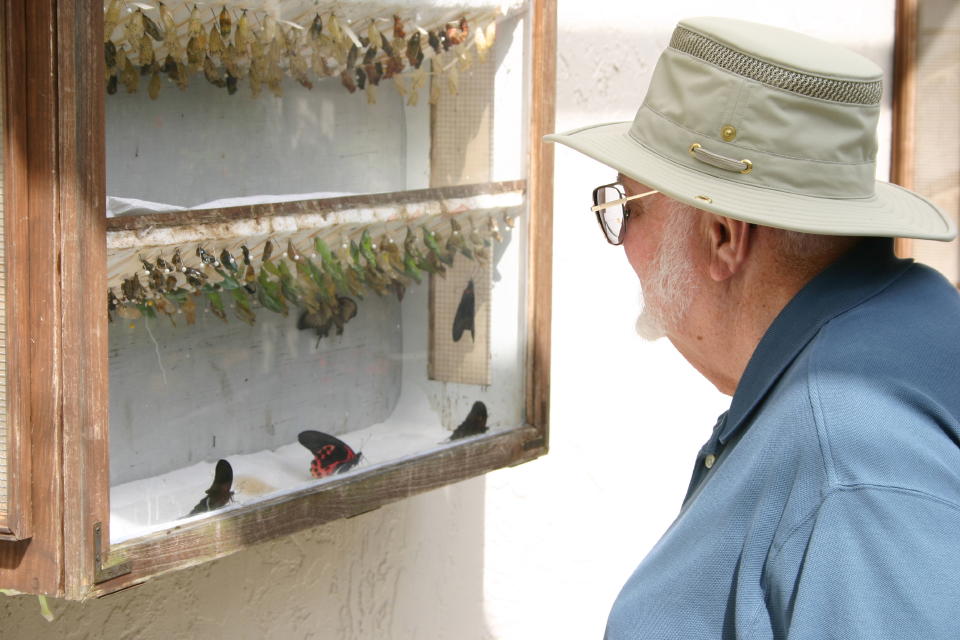
They reminded me of a recent visit to Butterfly World in Coral Springs with house guests from New Mexico. Here, our friend and former neighbor George examines an exhibit of butterflies emerging from their chrysalises.
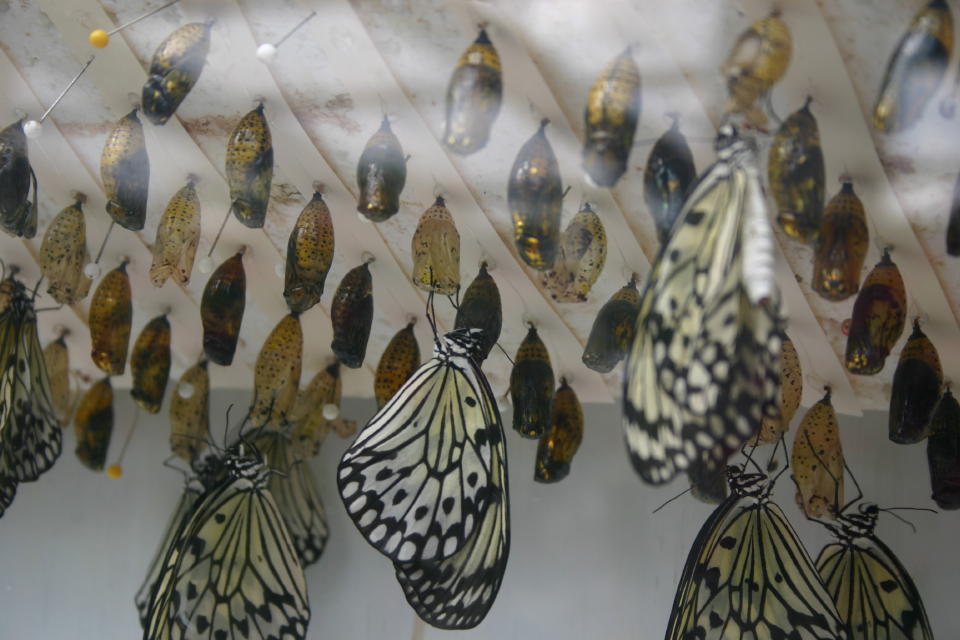
It is a shame that, despite my love of nature and my appreciation of the beauty of butterflies, I never tried to learn their names. Presumably, these are exotic species.
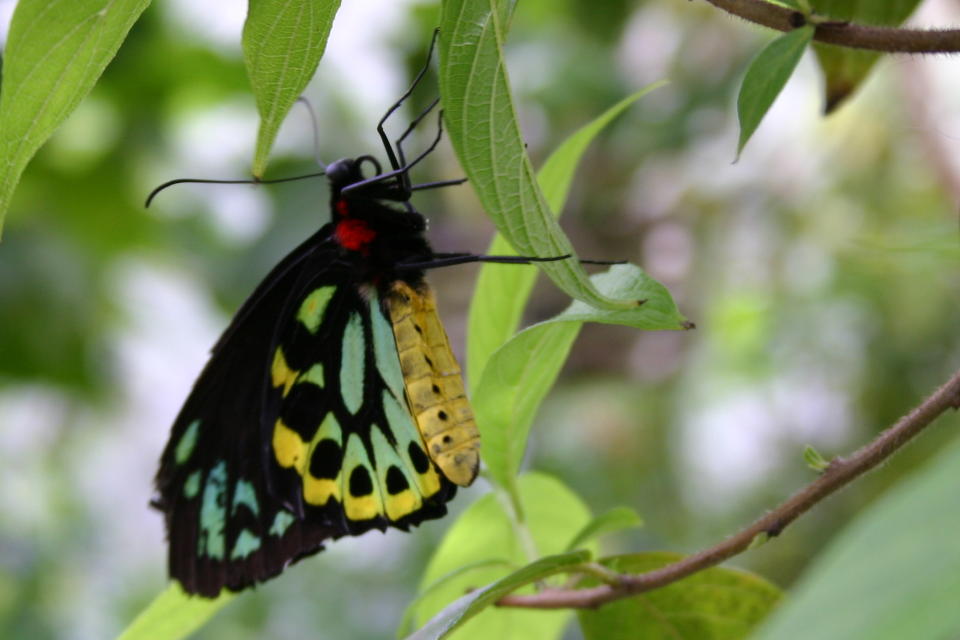
This one, unnamed species, was a standout.












